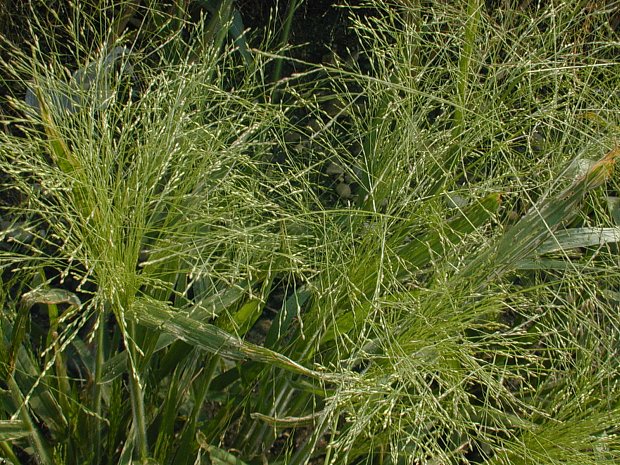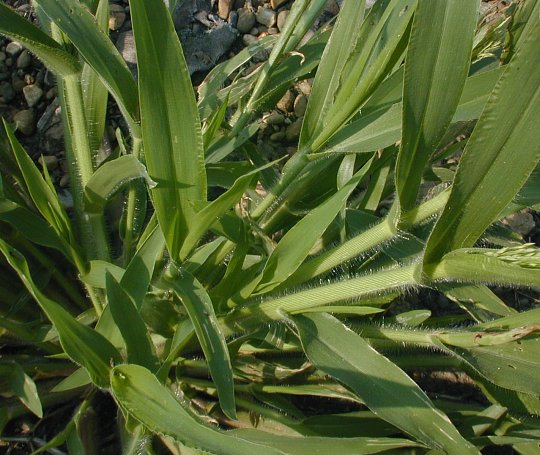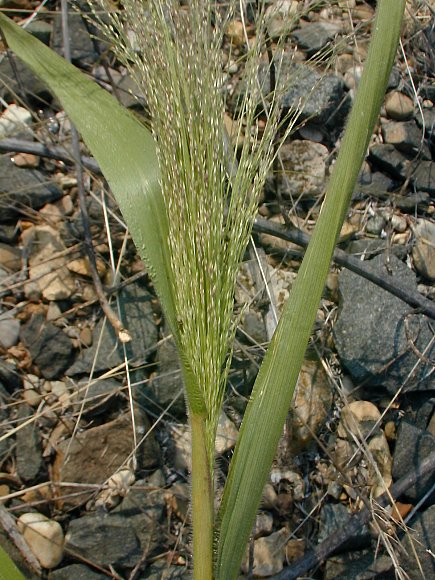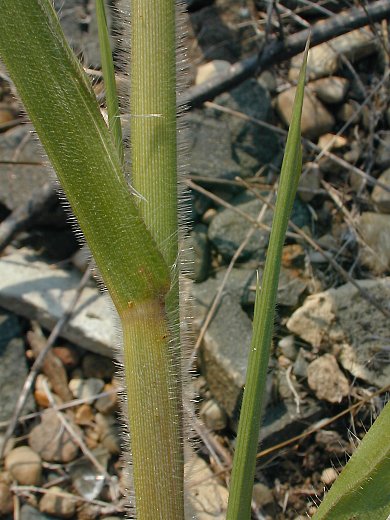Description: This grass is a summer annual about ¾–3' tall that is usually tufted at the base, sending up multiple leafy culms from the same crown, otherwise it is unbranched or sparingly so. The culms are light green, terete, and nearly hairless to hairy. The alternate leaves are more common toward the base of the culms. Their blades are up to 10" long, up to 16 mm. across, and rather floppy; they are light to medium green and variably hairy, often becoming rather ragged in appearance with age. The upper blade surface is hairless to densely covered with appressed hairs, while the lower blade surface has a few scattered hairs along the central vein, or it is moderately to densely covered with long spreading hairs. The leaf sheaths are light green to reddish green, longitudinally veined, and densely covered with long spreading hairs; they are wrapped rather loosely around the culms. The ligules are short-hairy.

Each culm terminates in a strongly branched panicle of solitary spikelets that is little-exerted from the uppermost leaf. Immature panicles are funnel-shaped with a dense concentration of branchlets and spikelets. Mature panicles are globular-ovoid in outline and airy in appearance from the widely spreading branchlets; they are up to 1½' long and 1' across. Mature panicles often comprise about one-half of the length of the entire plant. The light green rachis (central axis) of the panicle is hairy, particularly at the swollen nodes where the primary branches occur. These branches divide into slender branchlets; they are light green, rather wiry, stiff, and scabrous (rough-textured). The branchlets ultimately terminate in solitary spikelets with short pedicels. The spikelets of the typical variety of Witch Grass are about 2.0–2.5 mm. long, ellipsoid-ovoid in shape, and hairless; they taper gradually to beak-like tips. The scales of each spikelet consist of a short glume, a long glume (that looks like a lemma), and a single fertile lemma. The short glume is about one-third of the length of the spikelet, while the long glume is the same length as the spikelet and the lemma is a little shorter than the spikelet. The short glume is broadly ovate in shape; it often becomes pale purple, otherwise the scales of the spikelet are light green.

The blooming period occurs
during late summer and early fall, lasting about 2 weeks for a colony
of plants. The perfect florets of the lemmas are either
cross-pollinated by the wind or they are self-fertile. Shortly
afterwards, the panicles and their spikelets become
light tan. The entire panicle can detach from the plant and roll across
the ground like a tumbleweed, distributing the grains. Each spikelet
produces a single grain. The grains are about 1.5 mm. long, broadly
ellipsoid in shape, slightly flattened, and pointed at both
ends. The root system
is fibrous. This grass spreads by reseeding itself. It often occurs as
widely scattered plants in a given habitat, or it may form dense
colonies that are dominated by the airy panicles.
Cultivation:
The preference is full sun, mesic to dry conditions, and a barren soil
that contains sand, gravel, or hard-pan clay. Alkaline soil is readily
tolerated. The fertility of the soil and moisture level influence the
size of
individual plants. Because this grass has a C4 metabolism, most growth
and development occur during the summer and early autumn. Periods of
hot dry weather are readily tolerated.

Range &
Habitat:
The native Witch Grass is common throughout Illinois, where it has been
observed in most counties (see Distribution
Map). Habitats include disturbed areas of prairies (including
sand and gravel prairies), limestone and sandstone glades, chert and
granite glades, gravel bars near rivers, gravelly areas along railroads
(including the limestone ballast), fields, construction sites, and
barren waste areas. In
Illinois, this grass is a railroad weed primarily. It prefers open
disturbed areas where there is reduced competition from other ground
vegetation.
Faunal Associations:
The caterpillars of several skippers feed on the foliage of panic
grasses (Panicum spp.), including Hesperia
sassacus (Indian Skipper), Poanes hobomok
(Hobomok Skipper), Polites themistocles
(Tawny-Edged Skipper), and Wallengrenia egremet
(Northern Broken-Dash); also larvae of the leaf-miner moths Elachista radiantella
and Elachista solitaria
feed on these grasses (Bouseman et al., 2006; Needham et al., 1926).

Other insect feeders
include Chaetocnema
denticulata (Toothed Flea Beetle) and Chaetocnema pulicaria
(Corn Flea Beetle), leaf-mining larvae of the beetle Glyphuroplata pluto,
larvae of the fly
Cerodontha dorsalis (Grass Sheath Miner), stem-inhabiting
larvae of the gall fly Calamomyia
panici, the stilt bug Jalysus
spinosus, the plant bugs Collaria meilleuri
and Collaria oculata,
the stink bugs Euschistus
servus and Oebalus
pugnax, and such grasshoppers as Phoetaliotes nebrascensis
(Large-headed Grasshopper), Spharagemon
collare (Mottled Sand Grasshopper), and Arphia sulphurea
(Sulphur-winged Grasshopper). More more information, see Clark et al.
(2004), Needham et al.
(1928), Felt (1917), Froeschner (1942), Wheeler et al. (1983), Rider
(2009), Brust
et al. (2008), and Gangwere (1965). Several aphids suck plant juices
from Witch Grass (Kieckheffer & Lunden, 1983). These aphids
include Macrosiphum
avenae (English Grain Aphid), Rhopalosiphum maidis
(Corn Leaf Aphid), Rhopalosiphum
padi (Bird Cherry & Oat Aphid), and Schizaphis graminum
(Greenbug). The seeds of panic grasses are an important
source of food to upland gamebirds and granivorous songbirds (see Bird
Table). The foliage is occasionally eaten by rabbits and
hoofed mammalian herbivores, especially when it is young and tender.
According to Muenscher (1955), the seeds of Witch Grass have the
capacity to pass through the digestive tracts of horses, cattle, swine,
and sheep while remaining viable. Thus, these animals help to spread
this weedy grass into new areas.
Photographic Location:
A gravelly area along a railroad in Urbana, Illinois.

Comments: Witch Grass is a member of a small group of panic grasses (Panicum spp.) that are summer annuals with widely spreading panicles of small spikelets. These grasses are similar in appearance to each other and they can be difficult to distinguish. Witch Grass differs from another common species, Panicum dichotomiflorum (Fall Panicum) by its hairy sheaths; the latter species has hairless sheaths. Another species, Panicum milaceum (Broomcorn Millet), has been introduced from Eurasia. It has longer spikelets (about 5.0 mm. in length) and the branchlets of its inflorescence have a tendency to droop. In contrast, the branchlets of Witch Grass are rather stiff and straight. A less common variety of Witch Grass, Panicum capillare occidentale, has longer spikelets (about 2.5–3.5 mm. in length) and a panicle that is more exerted from the uppermost leaf. Two other species, Panicum philadelphicum and Panicum gattingeri, are sometimes considered varieties of Witch Grass as well. These latter two species have more narrow leaf blades (up to 8-10 mm. across) and they differ in other minor characteristics. See Mohlenbrock (2001) for a discussion of these differences.